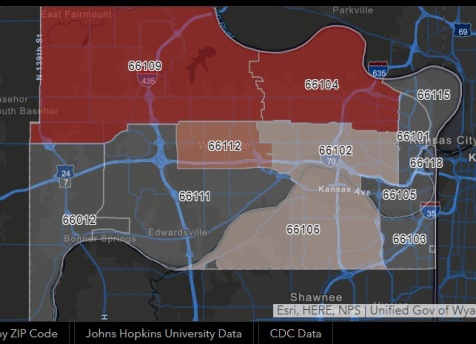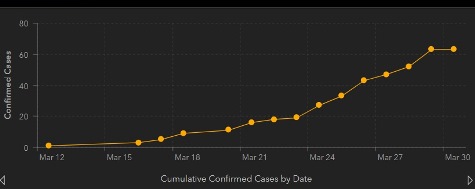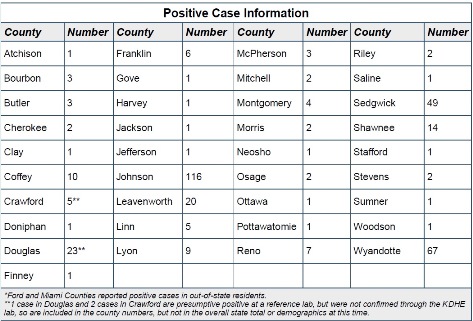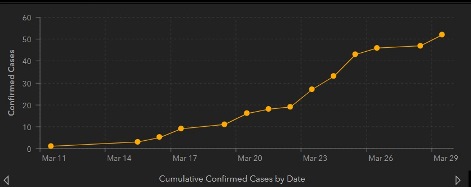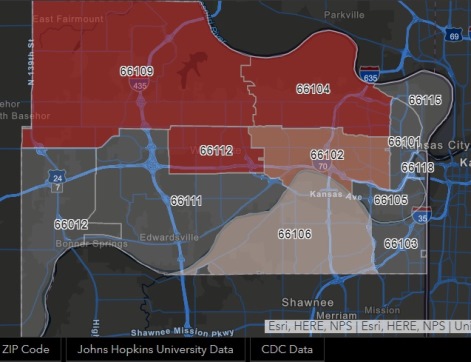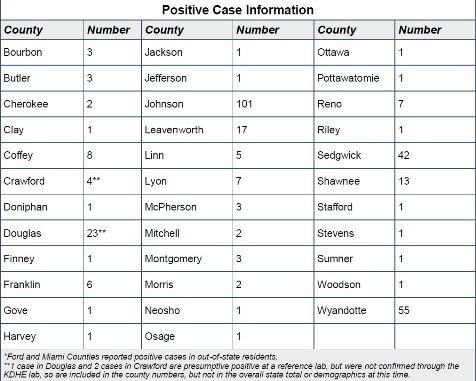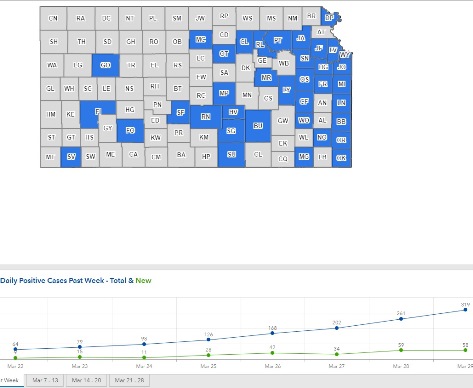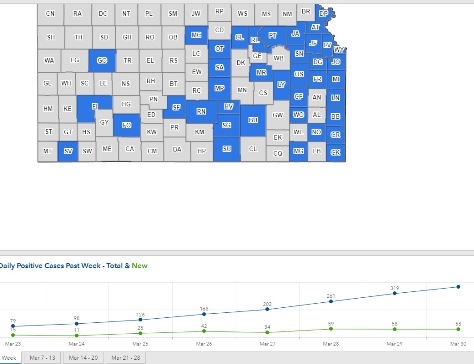
Wyandotte County reports 63 cases
State health officials today reported that positive COVID-19 cases had increased to 368 in Kansas.
It was an increase of 49 cases from Sunday’s total of 319, according to Dr. Lee Norman, Kansas health secretary.
The state now has eight deaths, Dr. Norman reported during a news conference. One death was reported on the weekend in Wyandotte County, which now has a total of four deaths.
Also, the death of a COVID-19 patient was reported in Crawford County, he said.
Dr. Norman also reported an outbreak in a skilled nursing facility operated by Life Care Center of Burlington in Coffey County, Kansas, where there were 7 to 8 positive COVID-19 cases. He said they are doing work to track how it reached the nursing home. One of the Wyandotte County COVID-19 deaths was from a patient who had been at the Life Care Center of Kansas City, Kansas. No other cases were reported at that center after testing, Dr. Norman said.
Wyandotte County reported an increase of 11 cases since Sunday. Wyandotte County reported 63 cases at 11 a.m. March 30, according to the Unified Government’s COVID-19 website.
There were 25 persons in Wyandotte County who were hospitalized with COVID-19. There were 52 COVID-19 cases listed on Sunday morning in Wyandotte County, with 23 persons hospitalized, according to the UG website.
Johnson County had 116 positive cases, according to KDHE statistics, as compared to 101 on Sunday.
Dr. Norman said new equipment is going online at the state labs that will allow the state to greatly increase testing and to do population studies. The state will be able to do more than 700 tests a day, he said.
The Kansas Department of Health and Environment has received numerous calls this week about groups that are gathering, including a church that held an event, he said. The governor’s stay-at-home order went into effect earlier today, and the state’s largest cities already were under local stay-at-home orders before that. Wyandotte County’s stay-at-home order started last Tuesday.
“It’s important for people to understand a stay-at-home order is in place and that goes for churches as well,” Dr. Norman said.
Dr. Norman said the number of COVID-19 cases typically doubles every three days, because each infected person typically infects another 4.64 persons. If they can change a 30 percent reduction in cases to 45 percent, the doubling time goes to 6.6 days, and then to 55 percent, the doubling time becomes 9.3 days, he said. It would help greatly and dramatically flatten the curve, he said.
That would reduce the number of total cases, which would then reduce the number of intensive care unit beds and ventilators needed, and would mean there would be enough bed space for those who are critically ill. Some other countries with COVID-19 ran out of ICU bed space and ventilators, and had to make decisions about which patients could receive ventilators and which ones couldn’t.
Using KU Hospital in Kansas City, Kansas, as an example, if restricted movement went from 45 percent to 55 percent, it would change the need from 2,000 beds to 500 beds, Dr. Norman said.
On a positive note, Dr. Norman said Kansas received a shipment of 15 pallets today from the national stockpile of personal protective equipment, including such items as masks and gowns. There also are efforts to encourage Kansas companies to manufacture items.
Doctors encourage people to keep practicing social distancing
Doctors at the University of Kansas Health System on Monday, during a news teleconference, encouraged people to keep practicing social distancing.
KU Hospital went from 18 positive COVID-19 patients to 22 and then to 23, according to the doctors.
The hospital has about 250 ventilators available, but it doesn’t know at this time how many it will need in the future, according to Tammy Peterman, executive vice president, chief operating officer, chief nursing officer of the KU Health System and president of the Kansas City division.
Dr. Steve Stites, chief medical officer at the KU Health System, said the COVID-19 pandemic doesn’t seem real to some people, but it becomes real when they know a victim.
Dr. Stites talked about his son, who is in his 20s and lives in a different household and was displaying mild cough and sore throat symptoms, although he was not diagnosed with COVID-19. He said it was hard, but he was careful to leave groceries at the doorstep, and not to be within 6 feet of his son. He added his son is getting better now.
He said there are some young people who have contracted COVID-19 in the Kansas City area.
“There’s a 25-year-old daughter of somebody here on a ventilator,” he said. “I don’t know how to make this more real for people.”
Dr. Dana Hawkinson, medical director of infection prevention and control at the KU Health System, said the disease affects all ages, including children. He urged residents to keep up the social distancing, wash their hands, don’t touch their faces and clean surfaces.
He said that while it was good to be outside over the weekend, he saw a lot of people who were not keeping 6 feet away from each other, including six or seven young people who were not from the same household.
“If it’s not a person in your household, you need to be at least 6 feet distant from them,” he said. He saw groups of friends meeting at the park, having pizza – “That’s the exact opposite of what we want,” he added. The doctors don’t want contact between households, and that is a way that coronavirus can spread, he said.
Dr. Hawkinson said they are going out of flu season and into allergy season, and the symptoms might be coughing and sneezing.
Dr. Stites said if it can be treated with products such as Benadryl, it’s probably not COVID-19, but allergies.
The symptoms of COVID-19 are a fever, a dry cough and difficulty breathing. People who have symptoms should call their primary physician and wait for a callback with instructions.
Peterman said the KU Health System appreciated the enormous outpouring of support, donations and words of encouragement to the staff during the past few weeks.
“We have a really generous and giving community,” she said. “I am grateful every day for the community we live in.”
More information from the KU Health Systems teleconference may be viewed online at
https://www.youtube.com/watch?v=Lyjrr9ZG8Fc.
More information from the Kansas Department of Health and Environment teleconference is at https://vimeo.com/showcase/6935373.
The UG’s COVID-19 response website is at
https://alpha.wycokck.org/Coronavirus-COVID-19-Information.
The Kansas COVID-19 website is at
https://govstatus.egov.com/coronavirus.
COVID-19 information from the CDC is at https://www.cdc.gov/coronavirus/2019-nCoV/index.html.
